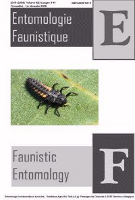Entomological and epidemiological investigations of an emerging focus of cutaneous leishmaniasis in Bzou, Morocco
Résumé
La leishmaniose cutanée (LC) à Leishmania tropica est très répandue au centre du Maroc où elle est endémique dans la province d'Azilal et ses régions. Au cours de ce travail, on a étudié l’écologie des phlébotomes, vecteurs de la maladie, et le profil épidémiologique des leishmanioses (2009-2012) dans le secteur de Bzou, qui renferme des foyers actifs de L. tropica. Ainsi, six localités appartenant au secteur de Bzou ont été prospectées de mars à novembre 2010. Un total de 488 spécimens a été capturé dans des biotopes domestiques et pré-domestiques en utilisant des pièges adhésifs et lumineux (CDC). 8 espèces ont été identifiées, dont 5 Phlebotomus spp. (96,31%) et 3 Sergentomyia spp. (3,69%). Pour le genre Phlebotomus, P. sergenti est le plus abondant (50,61%) suivi par P. papatasi, P. perniciosus, P. alexandri et P. longicuspis avec (23,16% ; 21,72% ; 0,61% et 0,20%) respectivement. Cependant, le genre Sergentomyia était moins fréquent, dominé par S. minuta (2,46%) suivi par S. fallax et S. dreyfussi avec (0,61%) chacune. A l’instar des autres foyers typiques de la LC au centre du Maroc, notre étude confirme l'implication de P. sergenti dans la transmission de L. tropica à Bzou.
Abstract
Cutaneous Leishmaniasis (CL) due to Leishmania tropica has become widespread in the central part of Morocco over the High-Atlas Mountains, and it occurs as endemic disease in Azilal province. The aim of this study is to give an overview of the density, richness, abundance and equitability of sand flies in Bzou district, focus of L. tropica, and to undertake a retrospective epidemiological study of CL between 2009 and 2012. Therefore, in the entomological survey, six localities have been prospected from March to November 2010. A total of 488 sand flies were trapped from both animal and human dwellings using light and sticky traps. Five species were identified as Phlebotomus spp. (96.31%) and three as Sergentomyia spp. (3.69%). For the genus Phlebotomus, P. sergenti was the most dominant (50.61%), followed by P. papatasi (23.16%), and P. perniciosus (21.72%). The other species P. alexandri and P. longicuspis represented only 0.61% and 0.20% respectively. However, the genus Sergentomyia was less frequent. S. minuta represented only 2.46% followed by S. fallax and S. dreyfussi with 0.61% for each one. Obviously, like other foci of cutaneous leishmaniasis in Morocco, our survey supports the implication of P. sergenti as a potential vector of L. tropica in Bzou.

